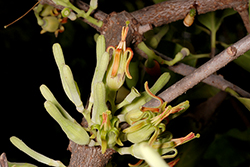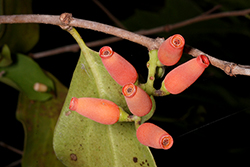e-Flora of Thailand
Volume 7 > Part 4 > Year 2002 > Page 675 > Loranthaceae > Dendrophthoe
6. Dendrophthoe pentandra (L.) Miq.wfo-0000641278
Fl. Ind. Bat. 1, 1: 818. 1856; Danser, Bull. Jard. Bot. Buitenzorg 3, 11: 417. 1931; l.c., 16: 28, 260. 1938, 1940; Barlow, Fl. Mal. I, 13: 318. 1997.— Loranthus pentandrus L., Mantissa 1: 63. 1767.
Accepted Name : This is currently accepted.
Synonyms & Citations :
Description : Glabrous except for the young shoots, inflorescences and flowers with a somewhat silky off-white to grey or less often rusty or brownish tomentum, usually less dense on the distal part of the corolla. Leaves scattered or subopposite; lamina variable, mostly narrowly to broadly elliptic, mostly 6–14 by (1.5–)3–8(–10) cm, attenuate to cuneate at the base to a petiole 5–20 mm long, rounded to rarely acuminate and acute at the apex, darker above, lustrous or sometimes glossy above and dull below or dull on both sides; venation pinnate with the midrib and the somewhat curvinerved main laterals usually visible on both sides. Inflorescences at the nodes, a 6- to 12-flowered raceme; axis 10–20(–35) mm long; pedicels (0.5–)1–4 mm long. Corolla in mature bud 5 merous, 12–20(–28) mm long (longer in some putative hybrids), inflated to ca 5 mm wide and angular or winged in the lower part, narrowed to a neck, clavate and obtuse or rounded at the apex, mostly green or yellow or orange, rarely red; tube in the open flower (2–)6–12 mm long, narrowly to broadly campanulate, usually regular, with the lobes reflexed 4–8 mm higher and together often almost closing the neck. Anther 2–5 mm long, obtuse, longer or shorter than the free part of the filament; filament often with very sparsely scattered stellate hairs.
Thailand : NORTHERN: Mae Hong Son, Chiang Mai, Chiang Rai, Phrae, Tak; NORTH-EASTERN: Loei, Khon Kaen; SOUTH-WESTERN: Kanchanaburi, Ratchaburi, Phetchaburi; CENTRAL: Phra Nakhon Si Ayutthaya, Krung Thep Maha Nakhon (Bangkok); SOUTH-EASTERN: Chon Buri, Rayong, Chanthaburi, Trat; PENINSULAR: Chumphon, Ranong, Phangnga, Phuket, Krabi, Nakhon Si Thammarat, Trang, Satun, Songkhla.
Distribution : From eastern India eastwards and southwards, throughout Thailand and Indochina, S China and Malesia as far east as the Philippines and Flores.
Ecology : Predominantly in humid forests but also in open and deciduous forests and plantations, common in lowlands up to 500 m alt., less frequently to 1,650 m, with numerous recorded hosts; in Thailand recorded from evergreen and deciduous forests and thickets, oak-pine forests, beach forests, mangroves and Melaleuca swamp forests, 0–1,300 m alt.; recorded as parasitic on the following genera: Acacia, Atalantia, Buchanania, Capinus, Chaetocarpus, Congea, Dalbergia, Delarix, Eugenia, Excoecaria, Ficus, Hymenodictyon, Litsea, Mangifera, Melaleuca, Phyllanthus, Quercus, Schefflera, Scleropvrum, Terminalia, Vatica, Willoughbiea.
Vernacular : Kafak ma muang (กาฝากมะม่วง)(Central).
Notes: In several parts of the species range there are extreme variants which are probably of hybrid derivation; in Thailand specimens with long corollas (> 20 mm), often with somewhat curved tubes, and/or longer tawny indumentum may be intergrades, especially with Dendrophthoe kerrii.


